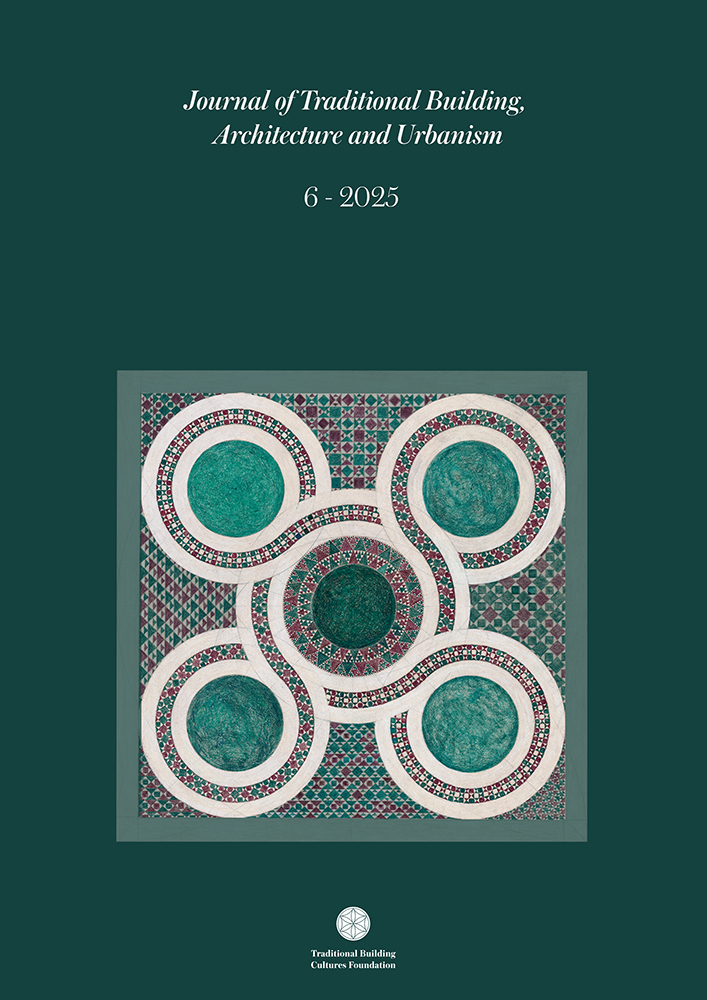Resumen
Este artículo presenta un análisis geométrico de cuatro edificios mogoles del siglo XVII con el objetivo de descifrar los métodos de diseño empleados por los arquitectos mogoles para crear sus obras maestras. El análisis geométrico se sitúa en el marco del esquema Hasht Bihisht (“Ocho Paraísos”), la planta arquetípica de la arquitectura mogol. Clasificado como un tipo de diagrama de “mandala de nueve cuadrados”, el Hasht Bihisht simboliza el cosmos, es decir, un universo creado en armonía. Nuestros hallazgos dan continuidad a las investigaciones sobre la arquitectura timúrida de Asia Central y se corresponden con los principios comunes a la arquitectura tradicional en general, vigentes hasta nuestros días, como se mostrará a través del trabajo de un maestro albañil heredero de esta tradición. En conclusión, se propone interpretar estos métodos de diseño a la luz de la cosmología tradicional.
Citas
Begley, Wayne Edison; and Desai, Ziyaud-Din A. 1989. Taj Mahal: The Illuminated Tomb: An Anthology of Seventeenth-century Mughal and European Documentary Sources. Cambridge: Aga Khan Program for Islamic Architecture.
Bulatov, Mitxat Sagadatdinovich. 1978. Geometric Harmonisation in the Architecture of Central Asia, IX – XV Centuries. Moscow: Nauka Publishers.
Burckhardt, Titus. 1976. The Art of Islam Language and Meaning. London: World of Islam Festival Publishing Company.
Chughtai, Muhammad Abdullah. 1957. Ustad Ahmed Mimar Lahori and His Family. Lahore.
Coomaraswamy, Ananada Kentish. 1934. The Transformation of Nature In Art. New York: Dover Publications.
Crane, Howard. 1987. Ris?le-i mi?m?riyye: an early-seventeenth-century Ottoman treatise on architecture : Facsimile with translation and notes. Leiden: Brill.
Guenon, Rene. 1972 [1945]. Reign of Quantity and the Signs of the Time. London: Penguin Books.
Golombek, Lisa; and Wilber, Donald. 1988. The Timurid Architecture of Iran and Turan. Princeton University Press.
Holod, Renata. 1988. Text, Plan and Building: On the Transmission of Architectural Knowledge. In Sevcenko, Margaret Bentley (ed.), Theories and Principles of Design in the Architecture of Islamic Societies. Cambridge: Aga Khan Program for Islamic Architecture.
Internet Encyclopedia of Philosophy. Aquinas: Metaphysics. https://iep.utm.edu/thomas-aquinas-metaphysics. (consulted on 12/05/2025)
Jarrett, H.S. (tr.). 1949. Ain-i-Akbari of Abul Fazl-i-?Allami. Calcutta: Royal Asiatic Society of Bengal.
Jones, Mark Wilson. 2006. Ancient Architecture and Mathematics: Methodology and the Doric Temple. Nexus VI: Architecture and Mathematics, 6: 1-20.
Koch, Ebba. 1991. Mughal Architecture. Munich: Prestel–Verlag.
Koch, Ebba. 2006. The Complete Taj Mahal and the Riverfront Gardens of Agra. London: Thames and Hudson 2006.
Leonardis, Rocco. 2016. Geometry in Greece The Use of Geometry by Ancient Greek Architects. In Miles, Margaret M. (ed.), A Companion to Greek Architecture. New York: John Wiley & Sons.
Meister, Michael W. 1985. Measurement and Proportion in Hindu Temple Architecture. Interdisciplinary Science Reviews, 10, 3: 248-258.
Nasr, Seyyed Hosein. 1978. An Introduction to Islamic Cosmological Doctrines. London: Thames & Hudson.
Necipoglu, Gulru. 1996. The Topkapi Scroll: Geometry and Ornament in Islamic Architecture. Los Angeles: Getty Publications.
Neihardt, John G. 1972. Black Elk Speaks, Being the Life Story of a Holy Man of the Oglala Sioux. New York: Washington Square Press.
Rossi, Corinna. 2007. Architecture and Mathematics in Ancient Egypt. Cambridge: Cambridge University Press.
Sevcenko, Margaret Bentley (ed.). 1988. Theories and Principles of Design in the Architecture of Islamic Societies. Cambridge: Aga Khan Program for Islamic Architecture.
Smith, Wolfgang. 1995. The Quantum Enigma, Finding the Hidden Key. New York: Angelico Press.
Stanford Encyclopedia of Philosophy. 2022. Thomas Aquinas. https://plato.stanford.edu/entries/aquinas/#FormMatt (consulted on 12/05/2025)
Stoddart, William. 1993. Outline of Hinduism. Bloomington: Foundation for Traditional Studies.
The Metropolitan Museum of Art. Architectural Drawing of a Garden. https://www.metmuseum.org/art/collection/search/544801 (consulted on 18/04/2025)
Ustad, Rahim Bakhsh. 1970s. Handbook of Assorted Architectural Drawings. Unpublished.
Wittkower, Rudolf. 1973. Architectural Principles in the Age of Humanism. London: Academy Editions.

Esta obra está bajo una licencia internacional Creative Commons Atribución-NoComercial-SinDerivadas 4.0.

